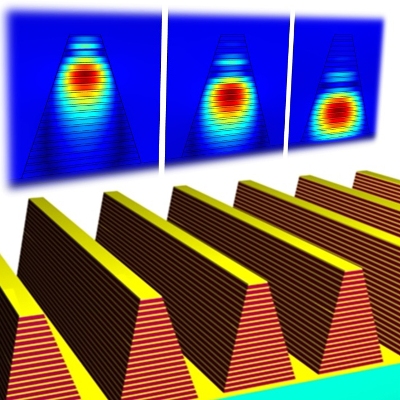A research team at Massachusetts Institute of Technology has developed a novel metamaterial for more efficient absorption of a broad range of light, paving the way to a new class of optical sensors and solar cells.
 Tapered ridges, made from alternating layers of metal and insulating material deposited on a surface, can produce a metamaterial that is tuned to a range of specific frequencies of light. Light of different wavelengths is absorbed by the material at different levels, where the light's wavelength matches the width of the ridges. (Image: Yanxia Cui)
Tapered ridges, made from alternating layers of metal and insulating material deposited on a surface, can produce a metamaterial that is tuned to a range of specific frequencies of light. Light of different wavelengths is absorbed by the material at different levels, where the light's wavelength matches the width of the ridges. (Image: Yanxia Cui)
The novel design of the metamaterial utilizes a wedge-shaped ridge pattern whose widths are accurately tuned to slow and trap light of a broad range of angles of incidence and wavelengths. This extremely thin metamaterial reduces cost and weight. The research team created the metamaterial’s structure by etching from alternating layers of a metal and a dieclectric. By altering the applied electric field, the response of a dieclectric material to a polarized light can be modified.
Kin Hung Fung, one of the researchers, informed that the novel multilayer sawtooth structure is capable of absorbing a broad range of frequencies with over 95% efficiency. This innovative design has a very broad window for light colors. This metamaterial slowed the speed of light to below one-hundredth of its usual speed in a vacuum, allowing it to easily trap and absorb the light.
This metamaterial can be easily produced utilizing existing photovoltaic-cell manufacturing equipment. The team’s preliminary research findings were based on computer simulations. It is now involved in lab experiments to verify its findings.
In addition to solar cells, the novel design finds applications in fabricating highly efficient infrared detectors for a specific range of wavelengths. Nicholas X. Fang, one of the researchers, informed that since the material may be a highly efficient absorber and emitter of photons, it can also be used in infrared-light emitting applications. Moreover, by scaling the principle, it can be used to release or trap devices electromagnetic radiation at terahertz and microwave frequencies. It is even capable of generating energy-efficient visible light, opening the door for a new class of highly efficient light bulb.